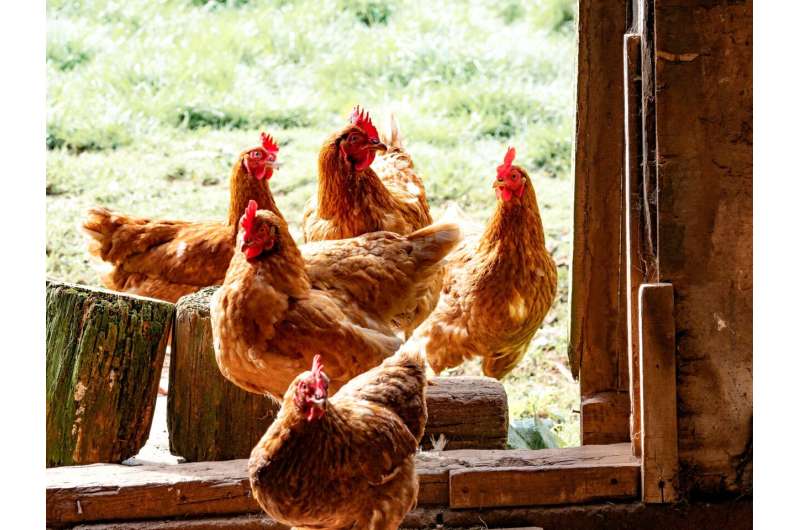This article has been reviewed according to Science X's editorial process and policies. Editors have highlighted the following attributes while ensuring the content's credibility:
fact-checked
trusted source
proofread
Using UV disinfection instead of antibiotics in poultry farming

Infectious diseases pose a huge problem in poultry farming. Poultry farmers are often forced to rely on antibiotics to tackle this issue. However, this can sometimes result in germs developing resistance to these drugs. These resistant pathogens then find their way into our food via animal products. The frequent use of antibiotics can therefore pose potential health risks to both animals and humans.
With the help of a compact device that combines several processes, including UV disinfection, photocatalysis and particle filtration, researchers at the Fraunhofer Institute of Optronics, System Technologies and Image Exploitation IOSB, Institute for Advanced Systems Technology (AST) have been working alongside their partners to sustainably reduce the use of antibiotics while improving the air quality in barns to promote animal welfare.
At large-scale farms, farmers are frequently obliged to administer antibiotics as a way to avoid outbreaks of serious diseases. However, germs can "get used to" the drugs and develop resistance to them. Another health hazard for the animals—and by extension humans—comes in the form of the air quality in barns. In farms, this is often caused by the ammonia and VOCs (volatile organic compounds) in animal excrement.
To respond to this, measures to improve barn hygiene and animal welfare are urgently required. Researchers at Fraunhofer IOSB-AST are working closely with PURION GmbH and the Gesellschaft zur Förderung von Medizin-, Bio- und Umwelttechnologien e. V. (GMBU) to develop an alternative to antibiotics that also acts as an air purifier for barns.
UV disinfection, photocatalysis and particle filtration have been combined with several processes that sterilize and remove harmful chemical compounds in the form of an innovative portable device, which can be attached to the ceiling, for example. This device should reduce the incidence of infectious diseases that require treatment with antibiotics.
The compact device can be quickly and flexibly integrated into existing poultry farming facilities. It is suited to closed barns and can therefore also be used in piggeries. In addition, it could also prove useful against viral diseases, such as in the fight against bird flu, which runs rampant in the winter months.
Disinfection and removal of harmful gases
The device uses UVC LEDs to continually disinfect the air in the barn. "Certain wavelengths of UV radiation have a powerful microbiocidal effect, deactivating pathogens by damaging their DNA," explains Thomas Westerhoff, scientist at Fraunhofer IOSB-AST, Ilmenau. Compared to conventional mercury vapor lamps, LEDs are resistant to vibrations, emit wavelengths with a greater microbiological efficiency that deactivate viruses, bacteria and fungi, and do not have a warm-up period. Additionally, they contain no mercury at all and so are also safe for the environment.
At present, UVA LEDs are commonly used to reduce chemical air pollution resulting from ammonia and VOCs on an ongoing basis. "UVA rays hit the photocatalytically active surfaces within the device. Photocatalysis occurs as a result of this process, which uses the moisture in the air to create highly reactive hydroxyl radicals to ensure that organic substances are oxidized and combusted. A number of organic compounds can more or less be broken down effectively," says the scientist.
The project will investigate how the wavelengths of the radiation source affect the efficiency of photocatalysis when combined with different photocatalysts. The findings will then be used to determine whether further improvements in performance are possible.
Innovation for the poultry farming sector
As part of this project, the researchers are also investigating and assessing various methods for adjusting the scale of photocatalytically active surface layers, as well as which of the many photocatalysts available is most efficient and suited to breaking down chemical compounds in barn air. A new filter system, aimed at reducing the accumulation of dust particles on the photocatalytic coating, will play a key role.
"The goal of our project is to develop a fully-fledged, mobile piece of apparatus—a true innovation for poultry farming. Reducing the use of antibiotics decreases the likelihood that further resistance will develop. It also lowers the amount of antibiotics that poultry products are exposed to. This also applies to the pollution of wastewater from poultry farming," explains the researcher.
Provided by Fraunhofer-Gesellschaft





















